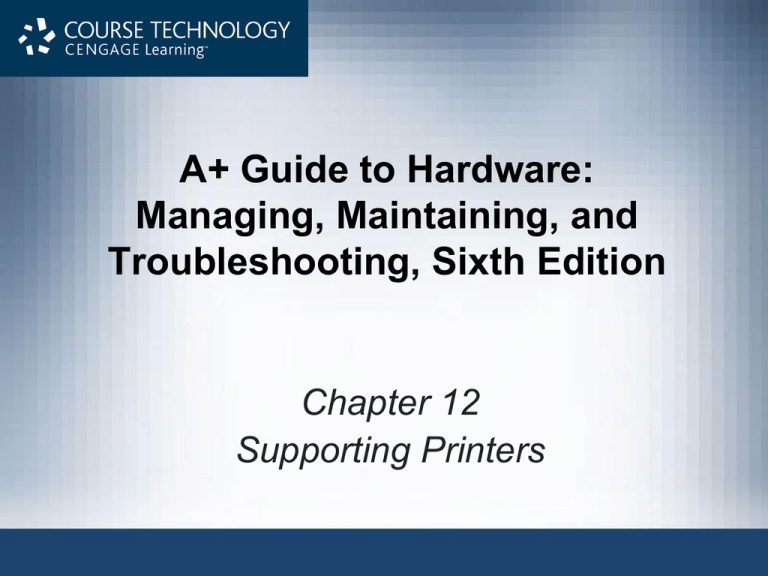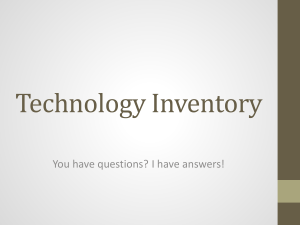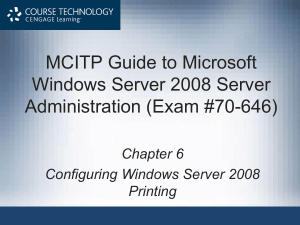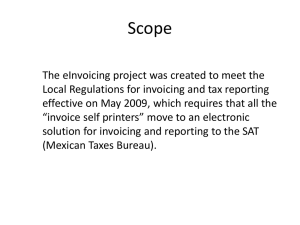ppt - LoriMCollier
advertisement

A+ Guide to Hardware: Managing, Maintaining, and Troubleshooting, Sixth Edition Chapter 12 Supporting Printers Objectives • Learn about printer types and features • Learn how to install printers and share a printers and how to manage printer features, add-on devices, and the printer queue • Learn about routine maintenance tasks necessary to support printers • Learn how to troubleshoot printer problems A+ Guide to Hardware, Sixth Edition 2 © Cengage Learning 2013 Printer Types and Features • Configure, repair, maintain printers – Requires knowledge of printer types and features • Understanding how a printer works – Helps in fixing printer problems A+ Guide to Hardware, Sixth Edition 3 © Cengage Learning 2013 Printer Languages • Communication methods between OS and printer – Printer uses PostScript commands to build the page – Printer uses PCL commands to build the page • PCL: Printer Control Language – Windows GDI builds page, then sends it to the printer • GDI: Graphics Device Interface – Windows 7/Vista uses XML Paper Specification (XPS) to build the page, then sends it to the printer • XPS (XML Paper Specification) – Raw data printed with little-to-no formatting A+ Guide to Hardware, Sixth Edition 4 © Cengage Learning 2013 Types of Printers • Major categories: – Laser, inkjet (ink dispersion), thermal printers, and impact printers Figure 12-1 Okidata C3200n color laser printer A+ Guide to Hardware, Sixth Edition 5 © Cengage Learning 2013 Laser Printers • Laser printer: electrophotographic printer – Uses mechanical, electrical, and optical technologies • How laser printers work: – Toner placed on electrically charged rotating drum – Toner deposited on paper moving at drum speed A+ Guide to Hardware, Sixth Edition 6 © Cengage Learning 2013 Laser Printers • Seven steps in laser printing: – Processing image: bitmap of final page stored in memory – Conditioning: drum surface charged to -600 V – Writing: laser beam writes -100 V image to drum surface – Developing: toner applied to -100 V areas of the drum – Transferring: toner drawn off drum and onto paper – Fusing: heat and pressure fuse toner to paper – Cleaning: drum cleaned of residual toner and charge • Color laser printing – Writing process repeated four times A+ Guide to Hardware, Sixth Edition 7 © Cengage Learning 2013 Laser Printers • Parts used in the charging, exposing, developing, and cleaning steps undergo the most wear • Toner cartridge needs replacing most often – Followed by image drum, fuser cartridge, and transfer assembly • Other printer parts that might need replacing: – Pickup roller – pushes forward a sheet of paper – Separation pad – keeps more than one sheet of paper from moving forward • Printer that is able to print on both sides of paper is called a duplex printer (double-sided printer) A+ Guide to Hardware, Sixth Edition 8 © Cengage Learning 2013 Inkjet Printers • Overview of inkjet printer technology – Uses a type of ink-dispersion printing • Doesn’t provide high-quality resolution of laser printers – Print head moves across paper • One line of text created with each pass – Ink applied to paper using matrix of small dots • Plates with magnetic charge direct path to the page – Different types of inkjets form droplets of ink in different ways • Most popular is the bubble-jet A+ Guide to Hardware, Sixth Edition 9 © Cengage Learning 2013 Inkjet Printers • Comparing inkjet to laser printers: – Usually slower – Images smudge on inexpensive paper • Use only paper designed for inkjet printers • Inkjet printer buying advice: – Printer using two or four separate cartridges Figure 12-4 The ink cartridges of an inkjet printer A+ Guide to Hardware, Sixth Edition 10 © Cengage Learning 2013 Impact Printers • Overview of impact printer technology – Best known impact printer: dot matrix printer – A print head moves across width of the paper – Pins are used to print matrix of dots on the page • Pins shoot against a cloth ribbon • Ribbon impacts paper and deposits ink • Dot matrix printer technology advantages: – Continuous tractor feed allows event and data logging – Can use carbon paper: print multiple copies – Extremely durable A+ Guide to Hardware, Sixth Edition 11 © Cengage Learning 2013 Impact Printers • Guidelines for maintaining print heads: – Keep the printer in a cool, well-ventilated area – Do not print over 50 to 75 pages without a cool down Figure 12-6 Keep the print head of a dot matrix printer as cool as possible so that it will last longer A+ Guide to Hardware, Sixth Edition 12 © Cengage Learning 2013 Thermal Printers • Use heat to create an image • Two types of thermal printers: – Direct thermal printer • Burns dots onto special coated paper (thermal paper) • Often used as receipt printers – Thermal transfer printer • Uses a ribbon that contains wax-based ink • Heating element melts ribbon onto thermal paper • Used to print receipts, bar code labels, clothing labels, or container labels • Reliable and easy to maintain A+ Guide to Hardware, Sixth Edition 13 © Cengage Learning 2013 Using Windows to Install, Share, and Manage Printers • Printers can connect to a single computer or a network – Local printer attached to a PC using a port or wireless connection – Network printer has an Ethernet port to connect directly or uses Wi-Fi to connect to an access point • OS compatible print drivers required – Use 32-bit drivers for a 32-bit OS and 64-bit drivers for a 64-bit OS – Windows 7 has many drivers built in or drivers can be downloaded from manufacturer’s website A+ Guide to Hardware, Sixth Edition 14 © Cengage Learning 2013 Figure 12-10 A shared local printer and a network printer A+ Guide to Hardware, Sixth Edition 15 © Cengage Learning 2013 Installing A Local or Network Printer • Ways to install a local USB printer – Plug in USB printer: Windows 7/Vista installs printer automatically – Launch the installation program • Installing a non-USB local printer or network printer using Windows 7/Vista – Verify printer on and available – In Windows 7 Control Panel click Devices and Printers • For Windows Vista, click Printers from Control Panel A+ Guide to Hardware, Sixth Edition 16 © Cengage Learning 2013 Installing A Local or Network Printer • Installing a non-USB local printer or network printer using Windows 7/Vista (cont’d) – Click Add a printer and select the type of printer – Windows searches for available printers • Select printer from the list and click Next – Tell Windows where to find the printer drivers – Follow the wizard to install the printer – Send a test page to ensure proper setup • A test page can be sent anytime through the Printer Properties dialog box A+ Guide to Hardware, Sixth Edition 17 © Cengage Learning 2013 Install a Local Printer Using Windows XP • Installation begins differently depending on port – FireWire, USB, PC Card, ExpressCard, wireless • Software installation or printer connection order vary • Review printer documentation • Generals steps – – – – – Run setup program as an administrator Connect the printer to the port when instructed Close New Hardware Found Wizard Make selection for default printer Test the printer A+ Guide to Hardware, Sixth Edition 18 © Cengage Learning 2013 How to Install a Local Printer Using Windows XP • Printer installation using a parallel port – Serial and parallel ports: not hot-pluggable • Generals steps – Plug printer into the port, turn on the printer – If installing drivers from manufacturer’s program: • Launch printer setup program, followed directions – If using the Windows installation process: • Open Printers and Faxes window, click Add a printer • Follow Add Printer Wizard directions • Print a test page A+ Guide to Hardware, Sixth Edition 19 © Cengage Learning 2013 Figure 12-19 Use the Add Printer Wizard to install a printer A+ Guide to Hardware, Sixth Edition 20 © Cengage Learning 2013 Steps To Install a Network Printer Using Windows XP • Follow manufacturer directions • General steps – Open XP Printers and Faxes window • Start the wizard to add a new printer • Select option to install a local printer • Do not ask Windows to automatically detect printer – Choose Create a new port • Select Standard TCP/IP Port, Click Next twice – Identify the printer on the network – Click Have Disk A+ Guide to Hardware, Sixth Edition 21 © Cengage Learning 2013 Figure 12-22 Configure a local printer to use a standard TCP/IP port. Figure 12-23 Enter the printer name or IP address to identify the printer on the network. A+ Guide to Hardware, Sixth Edition 22 © Cengage Learning 2013 Sharing an Installed Printer • Windows 7: make sure Turn on file and printer sharing is selected • Vista: Printer sharing must be turned on • XP: File and Printer Sharing must be installed • General steps for Windows 7/Vista/XP – Open Properties dialog box, select Sharing – Select Share this printer, enter name for the printer – Make drivers available in Additional Drivers window • 32-bit operating systems: select x86 • 64-bit operating systems: select x64 A+ Guide to Hardware, Sixth Edition 23 © Cengage Learning 2013 Installing a Shared Printer • Two ways to install a shared printer on a remote computer – Use Windows 7 Devices and Printers window, Vista Printer window or XP Printers and Faxes window – Use Windows Explorer, the Network, or My Network Places window Figure 12-26 Install a shared printer using Windows Explorer A+ Guide to Hardware, Sixth Edition 24 © Cengage Learning 2013 Managing Printer Features and Add-on Devices • Use the printer Properties box to: – Manage printer features and hardware devices – Click the Device Settings tab • Manage duplex printing and paper sizes – Useful option: print a test page Figure 12-27 The Device Settings for an HP printer A+ Guide to Hardware, Sixth Edition 25 © Cengage Learning 2013 Managing Printer Features and Add-On Devices • After you have installed a new printer add-on: – Equipment or feature is listed as an option in the Printing Preferences box • Examples: input trays and feeders, staplers, sorters, stackers, binders, output trays to sort output by user Figure 12-29 Printing on both sides of the paper A+ Guide to Hardware, Sixth Edition 26 © Cengage Learning 2013 Managing the Printer Queue • Spooling: process of queuing print requests from application – Print spooler: print queue • To manage print queue: double-click the printer icon in Windows 7 Devices and Printers window – If the printer reports a problem with printing, will be displayed as the status for the first job in the queue – To cancel a print job, right-click the job and select Cancel from shortcut menu • To cancel all print job, click Printer and select Cancel All Documents A+ Guide to Hardware, Sixth Edition 27 © Cengage Learning 2013 Figure 12-30 Manage the printer queue A+ Guide to Hardware, Sixth Edition 28 © Cengage Learning 2013 Printer Maintenance and Upgrades • Extending printer working life – Follow manufacturer’s directions for device use – Perform necessary routine maintenance A+ Guide to Hardware, Sixth Edition 29 © Cengage Learning 2013 Online Support for Printers • On printer manufacturer’s web site look for: – Online documentation – Knowledge base of common problems • Explanation of what to do about them – – – – – Updated device drivers Replacement parts Printer maintenance kits Additional software Firmware updates A+ Guide to Hardware, Sixth Edition 30 © Cengage Learning 2013 Figure 12-31 Symbols imprinted on a device that indicate danger A+ Guide to Hardware, Sixth Edition 31 © Cengage Learning 2013 Online Support for Printers • Protection when working inside a printer – – – – Turn printer off, unplug it, wait about 30 minutes Never look at laser beam Use an antistatic ground bracelet Have help nearby • General directions to replace a cartridge: – Turn on printer and open front cover – Printer releases the cartridges so you can then open the latch on top of the cartridge to remove it – Install new cartridge A+ Guide to Hardware, Sixth Edition 32 © Cengage Learning 2013 Figure 12-32 Installing an ink cartridge in an inkjet printer A+ Guide to Hardware, Sixth Edition 33 © Cengage Learning 2013 Cleaning a Printer • As part of routine printer maintenance: – – – – – Clean outside of the printer with a damp cloth Do not use ammonia-based cleaners Clean the inside of the printer with a dry cloth Do not blow out toner with compressed air Two safe tools: • Toner-certified vacuum cleaner • Extension magnet brush – Software may be used to clean inkjet nozzles and calibrate/align cartridges • Cartridge nozzles may have to be manually cleaned A+ Guide to Hardware, Sixth Edition 34 © Cengage Learning 2013 Figure 12-33 Clean the area around the nozzle plate with a damp cotton swab A+ Guide to Hardware, Sixth Edition 35 © Cengage Learning 2013 Printer Maintenance Kits • Printer maintenance kit – Specific printer components – Step-by-step instructions for performing maintenance – Special tools or equipment: utilities and printer buttons • Examples of replacing printer consumables (follow steps outlined on pages 613-617) – Replacing a toner cartridge – Replacing an image drum – Replacing a fuser A+ Guide to Hardware, Sixth Edition 36 © Cengage Learning 2013 Upgrade the Printer Memory or Hard Drive • Internal hard drives hold print jobs and fonts • Extra memory can speed up memory performance, reduce print errors, prevent Out of Memory errors • General installation: – Use a screwdriver to remove printer cover plate – Remove thumb screws on the back of the printer, pull out the formatter board • Memory modules and hard installed on this board • Hard drive embedded on proprietary board that fits in the bay • Enable and configure using printer Properties window A+ Guide to Hardware, Sixth Edition 37 © Cengage Learning 2013 Figure 12-46 Memory is installed on the formatter board A+ Guide to Hardware, Sixth Edition 38 © Cengage Learning 2013 Print Servers and The Print Management Tool • Print server: hardware or software that manages print jobs sent to one or more printers on a network – Can be: • A dedicated hardware device • Software installed on a computer on the network • Programs embedded in firmware on a printer • Embedded firmware print server – Manage print jobs, view printer status, see job history, and check counters – Utilities are access through a browser A+ Guide to Hardware, Sixth Edition 39 © Cengage Learning 2013 Print Servers and The Print Management Tool • Windows Print Management – Available in Windows 7/Vista professional and business editions – Use it to monitor and manage printer queues for all printers on a network • In Print Management, each computer on the network that shares a printer is considered a print server A+ Guide to Hardware, Sixth Edition 40 © Cengage Learning 2013 Troubleshooting Printers • Section topics: – General printer troubleshooting – Troubleshooting specific problems • General tasks performed during troubleshooting – – – – – Interview the user Find out what works and does not work Make an initial determination of the problem When the problem is solved, check with the client Document problem symptoms and solutions A+ Guide to Hardware, Sixth Edition 41 © Cengage Learning 2013 Printer Does Not Print • Use flowchart on next slide to isolate problem • Isolate problem to one of the following areas: – – – – – The printer itself Connectivity between the PC and its local printer Connectivity between the PC and a network printer OS and printer drivers Application attempting to use the printer A+ Guide to Hardware, Sixth Edition 42 © Cengage Learning 2013 Figure 12-52 How to isolate a printer problem. A+ Guide to Hardware, Sixth Edition 43 © Cengage Learning 2013 Printer Does Not Print • Problems with the printer itself – Verify that the printer is on • Print a self-test page • Review test page for clues – Test page not printing • Troubleshoot the printer until it prints correctly: check paper issues, cover issues, cartridges installed, power source issues, reset the printer, check documentation – Test page will not print at all • Take printer to a certified repair shop A+ Guide to Hardware, Sixth Edition 44 © Cengage Learning 2013 Printer Does Not Print • Problems with a local printer cable or port – Verify cable firmly connected at both ends • For a USB port, try a different port – – – – – Try a different cable, use a shorter cable Use same printer and cable with different PC Use Device Manager to verify the port is enabled Use BIOS setup to check how the port is configured Use a port tester to test the port A+ Guide to Hardware, Sixth Edition 45 © Cengage Learning 2013 Printer Does Not Print • Problems with connectivity for a network printer or shared printer – If self-test page prints but Windows test page does not print then connectivity might be the issue • • • • • • Verify printer is online, power cycle printer, reboot PC Verify correct default printer selected Check IP address information Delete and reinstall printer Verify configuration, ping the printer, run diagnostics Research error codes, flash firmware A+ Guide to Hardware, Sixth Edition 46 © Cengage Learning 2013 Printer Does Not Print • Problems with connectivity for a shared printer – Print a test page from local computer – Verify correct default printer selected and online – At remote computer, verify access to the computer to which printer attached – Delete printer and reinstall – Print to another shared printer – Verify hard drive space A+ Guide to Hardware, Sixth Edition 47 © Cengage Learning 2013 Printer Does Not Print • Problems printing from Windows – – – – – – – – – Delete all print jobs in the printer’s queue Verify correct printer selected and online Verify cable connections Stop and restart Windows Print Spooler service Delete printer and reinstall Check for updated driver Try to print to a file Verify that enough hard drive space is available Print from Safe Mode A+ Guide to Hardware, Sixth Edition 48 © Cengage Learning 2013 Printer Does Not Print • Problems printing from applications – – – – – Verify correct printer Printing a different file within same application Cancel print jobs in the queue and reboot computer Create data in a new file and try to print it Print from another application • If you can print from other applications, consider reinstalling the problem application – Close any applications that are not being used – Add more memory to printer A+ Guide to Hardware, Sixth Edition 49 © Cengage Learning 2013 Poor Print Quality • Can be caused by printer drivers, application, Windows, or the printer • Poor print quality for laser printers: – – – – – – – Unplug printer and allow to cool for 30 minutes Rock or replace toner cartridge EconoMode (uses less toner) might be on; turn off Paper quality might not be high enough Printer might need cleaning Ensure printer does not require routine maintenance Laser drum might need replacing A+ Guide to Hardware, Sixth Edition 50 © Cengage Learning 2013 Poor Print Quality • Poor print quality for laser printers (cont’d): – Distorted images can be caused by foreign material – If page has a gray background, image drum is worn out and needs replacing • Ghosted images are usually caused by a problem with the image drum • Poor print quality for inkjet printers: – Is the correct paper quality being used? – Is the ink supply low? Remove and reinstall cartridge – Follow printer’s documentation to clean each nozzle A+ Guide to Hardware, Sixth Edition 51 © Cengage Learning 2013 Poor Print Quality • Poor print quality for inkjet printers (cont’d): – Clean sponge near carriage rest – If printing transparencies, change the fill pattern in your application • Poor print quality for impact printers: – Ribbon might need replacing – Adjust the print head spacing – Check the print head for dirt A+ Guide to Hardware, Sixth Edition 52 © Cengage Learning 2013 Poor Print Quality • Garbled characters on paper: – Cancel all print jobs in the queue and try printing a different document from the same application – Print using a different application – Is USB cable securely connected at both ends? – Power down printer by pressing a Reset button – Update printer drivers – Printer might needs servicing A+ Guide to Hardware, Sixth Edition 53 © Cengage Learning 2013 Poor Print Quality • Low memory errors – Possible indications of low memory • Only part of page print • Printer may have a flashing light • Printer may display message on display panel such as: – “20 Mem Overflow”, “Out of memory”, or “Low Memory” – Install more memory or print only simple pages with few graphics – Print a self-test page to verify how much memory is installed A+ Guide to Hardware, Sixth Edition 54 © Cengage Learning 2013 Poor Print Quality • Wrong print colors: – Some paper is designed to print on only one side • Try flipping the paper over – Adjust the quality of print – For an inkjet printer, try cleaning the ink cartridges and calibrating the printer – For a laser printer, try calibrating the printer A+ Guide to Hardware, Sixth Edition 55 © Cengage Learning 2013 Summary • Languages that Windows can use with printing are PostScript, PCL, GDI, and XPS • Two most popular printers are laser and inkjet • Seven steps of laser printing include: processing, charging, exposing, developing, transferring, fusing, and cleaning • Inkjet printers print by shooting ionized ink at a sheet of paper • Dot matrix printers are a type of impact printer • Direct thermal printers use heat to burn dots into special paper A+ Guide to Hardware, Sixth Edition 56 © Cengage Learning 2013 Summary • A printer is installed as a local printer connected directly to PC or a network printer • Under Windows7/Vista/XP, you can install a printer by launching a setup program on the CD that came with the printer • You can share an installed printer on a network • Network printers are usually identified by an IP address • An inkjet or laser printer can be calibrated to align color on the page A+ Guide to Hardware, Sixth Edition 57 © Cengage Learning 2013 Summary • Check the page count of the printer to know when service is due • Memory and a hard drive can be added to improve performance • Use a print server to manage printers on a network – The Print Management tool in Windows can be used • Poor print quality can be caused by printer drivers, the application, Windows, or the printer • A printer needs memory to render a print job – If low on memory, add more memory A+ Guide to Hardware, Sixth Edition 58 © Cengage Learning 2013







